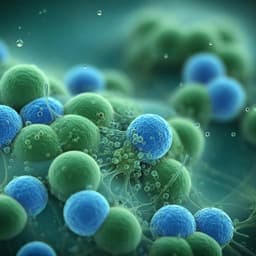
Engineering and Technology
Holding water in a sieve—stable droplets without surface tension
N. P. Longmire, S. L. Showalter, et al.
Discover groundbreaking research by N. P. Longmire, S. L. Showalter, and D. T. Banuti, revealing a fascinating new mechanism for sharpening interfacial density gradients without surface tension. This innovative work challenges conventional wisdom about phase interfaces and supercritical fluids, paving the way for enhanced fuel injection and heat transfer in high-pressure systems.
~3 min • Beginner • English
Introduction
The study asks whether stable droplet- and bubble-like interfaces can exist in pure supercritical fluids without surface tension or phase equilibrium, contrary to classical expectations. Motivated by observations of droplet-like structures under nominally supercritical conditions and by the concept of pseudoboiling (a supercritical liquid–gas transition occurring over a finite temperature interval along the pseudoboiling line), the authors hypothesize that spatial temperature gradients can induce and stabilize sharp density interfaces. They propose thermal gradient-induced interfaces (TGIIF) as a mechanism whereby a temperature difference between a cold/dense region and a warm/light environment leads to self-steepening density gradients. This challenges traditional interpretations that invoke mixture-induced subcritical pockets and phase equilibrium to explain droplets at supercritical pressures. The work has practical relevance to high-pressure injection and heat-transfer systems (e.g., diesel, jet, rocket engines, and supercritical power cycles), where strong temperature gradients are common.
Literature Review
Prior studies of droplets and sharp interfaces at supercritical pressures generally attribute them to phase separation in mixtures, where local compositions can fall below mixture critical pressures enabling equilibrium two-phase behavior (e.g., Delplanque & Sirignano 1993; Yang et al. 1994; Sirignano & Delplanque 1999; Qiu & Reitz 2015; Ma et al. 2019). On the molecular scale, interfacial thickness and non-equilibrium interface dynamics in mixtures have been analyzed extensively (Bellan 2000; Yang 2000; Dahms & Oefelein 2015). More recently, a supercritical transition termed pseudoboiling has been recognized, connected to the Widom line and defined via isobaric heat capacity maxima and Gibbs free energy curvature (Banuti 2015; Banuti et al. 2020; Maxim et al. 2021). Heat transfer deterioration in supercritical flows has been linked to pseudoboiling. However, most existing droplet/interface analyses focus on mixtures and phase equilibrium, leaving open the question of whether true supercritical, pure-fluid droplets can form and persist without surface tension or phase coexistence. This work addresses that gap by proposing a heat-transfer-driven mechanism for interface formation and stability in pure supercritical fluids.
Methodology
The authors derive conditions for the existence and stability of sharp density interfaces under constant pressure with no surface tension, focusing on pure fluids subject to imposed temperature gradients. Starting from the thermodynamic relation p(T) at constant pressure and applying spatial derivatives, they derive a necessary condition for a spatial density inflection point (defining an interface) in steady state. Combining Fourier’s law with steady heat conduction yields a criterion linking the sign of the second temperature derivative of pressure, p_TT, to the temperature dependence of thermal conductivity, k_T. The necessary condition for an interface is sgn(p_TT) = sgn(k_T), which depends solely on fluid properties and not on boundary conditions. They evaluate this criterion across fluid states (ideal gas, liquid, transcritical, and very high supercritical pressures) using isobaric property trends, identifying regions (notably between the pseudoboiling temperature T_pb and the temperature at which k reaches a minimum, T′ with k(T′)=k_min) where interfaces can form. Analytical model: A one-dimensional, steady, conduction-only configuration with two parallel walls at temperatures T_c (cold) and T_h (hot) is examined. The thermal conductivity is approximated piecewise linearly with separate liquid-like and gas-like branches across an interface temperature, enabling closed-form expressions for T(x) on each side derived from Fourier’s law. The model predicts temperature and density profiles and the existence of a density inflection point consistent with the interface criterion. CFD simulations: The analytical results are compared against simulations using the open-source SU2 solver (low-Mach formulation, flux-difference splitting scheme with MUSCL for second-order accuracy). Real-fluid properties are supplied via tiny neural networks (TNN) trained to capture supercritical thermophysical behavior (for n-heptane and oxygen), with property data sourced from CoolProp and NIST. Steady 1D cases at various pressures (including ideal gas, transcritical at 7 MPa, and very high pressure at 100 MPa) validate the analytical model’s predictions of interface existence and profile shape. Transient 2D droplet simulations: A parametric study of n-heptane droplets embedded in warm supercritical gaseous environments explores transient interface evolution and vaporization. Parameters include farfield reduced temperatures T_r = [1, 1.5, 2, 2.5], reduced pressures P_r = [1.5, 2, 4, 6], and initial droplet diameters D = [0.001, 0.01, 0.1] m. Initial density profiles are linear across the droplet–environment region. Diagnostics include maximum spatial density gradient (as interface indicator), shape evolution (elliptical to circular), and interfacial temperature. Time-scale and nondimensionalization: From transient heat conduction, a characteristic time τ ∝ D^2/α is identified (α the thermal diffusivity). The authors define a vaporization number Va = θ τα/(ΔT D^2), where θ is the temperature at which α is minimal (pressure-dependent), and ΔT is the temperature difference between warm gas and cold liquid. Va serves as a proportionality constant relating the conduction timescale to droplet lifetimes across conditions. Mesh details for 2D cases include refined regions around the interface; steady-state 1D validation cases compare SU2 results with the linear k-model across multiple pressures.
Key Findings
- Necessary condition for interfaces without surface tension: Under constant pressure and steady conduction, interfaces defined by density inflection points can exist if sgn(p_TT) = sgn(k_T). This condition holds in a transcritical temperature window (T_pb < T < T′ where k has a minimum) but not in ideal gases or typical liquids. - Existence over wide pressures: Interfaces can exist at high subcritical and very high supercritical pressures; no upper pressure limit was found for the presence of a density inflection point in the analyses. - Analytical vs CFD agreement: A piecewise-linear thermal conductivity model yields analytical temperature and density profiles in excellent agreement with SU2 simulations for ideal gas, transcritical (e.g., 7 MPa, p/p_cr ≈ 1.2), and very high pressure (100 MPa, p/p_cr ≈ 20) cases. - Transient interface sharpening and shape stability: In 2D droplets, initially diffuse density profiles sharpen over time when ΔT is sufficiently large; elliptical cross-sections regress toward circular shapes, demonstrating interface stability without surface tension. - D^2 vaporization law: For TGIIF conditions, the squared droplet diameter D^2 decreases linearly with time, analogous to the classical subcritical Spalding D^2 law. For T_r < 2 and P_r < 4, droplets may initially grow before following the D^2 relation; for sufficiently high ΔT, curves collapse. - Interfacial temperature pinned to pseudoboiling: The temperature at the interface closely matches the pseudoboiling temperature T_pb across environmental temperatures for P_r ≤ 3; deviations increase for P_r > 3 but T_pb remains a weak attractor. - Vaporization number: A single nondimensional constant Va = 0.31 collapses droplet lifetimes across five decades with ≈50% accuracy using τ = Va θ D^2/(ΔT α). - Parameter space mapping: Across T_r ∈ [1, 1.5, 2, 2.5], P_r ∈ [1.5, 2, 4, 6], and D ∈ [0.001, 0.01, 0.1] m, the study maps conditions yielding TGIIF (stable) vs diffuse interfaces; higher pressures require larger ΔT for TGIIF and yield smaller maximum density gradients. - Practical implications: TGIIF provide a mechanism to stabilize droplet-like structures and interfaces in pure supercritical fluids without surface tension, offering a physical basis for two-layer models in supercritical heat transfer and potentially informing optimization of high-pressure injection and heat transfer processes.
Discussion
The findings directly address whether stable droplet-like interfaces can exist in pure supercritical fluids without phase equilibrium: they can, provided thermophysical properties satisfy sgn(p_TT) = sgn(k_T) under imposed temperature gradients. This fundamentally reframes the interpretation of observed spherical structures in high-pressure injections, showing that surface tension and phase coexistence are not prerequisites for interface stability. The transient behaviors—interface sharpening, circularization of shapes, D^2 vaporization law, and interface temperatures pinned to T_pb—mirror classical subcritical evaporation phenomena, suggesting that heat-transfer-driven stabilization via TGIIF is a robust mechanism. The analytical model, grounded in first principles and relying only on property trends, agrees with CFD simulations using realistic real-fluid properties, reinforcing confidence in the mechanism. TGIIF’s dependence on fluid-property sign changes near pseudoboiling explains why such interfaces are absent in ideal gases and typical liquids, yet present in transcritical regions and persistent even at very high pressures. The introduction of the vaporization number Va enables predictive scaling of droplet lifetimes, offering a practical tool for engineering applications in high-pressure injection and supercritical heat transfer systems.
Conclusion
This work introduces thermal gradient-induced interfaces (TGIIF) as a new mechanism enabling stable droplets, bubbles, and planar interfaces in pure supercritical fluids without surface tension or phase equilibrium. It establishes a thermodynamic-transport criterion for interface existence, demonstrates analytical and numerical agreement across a wide pressure range, and reveals transient behaviors analogous to classical subcritical droplet evaporation, including D^2 vaporization and interface temperatures at T_pb. The proposed vaporization number Va = 0.31 provides a compact scaling for droplet lifetimes over broad conditions. The results broaden the conceptual definition of droplets and interfaces in supercritical regimes and justify two-layer models for supercritical heat transfer. Potential future directions include extending analyses to multi-component mixtures with reactive effects, incorporating flow and convection beyond conduction-only scenarios, exploring turbulence–TGIIF interactions, and experimental validation of TGIIF under engine-relevant conditions.
Limitations
- Property modeling and approximations: Real-fluid thermophysical properties in transcritical regimes are challenging; the analytical model uses a piecewise-linear approximation of thermal conductivity. While validated against SU2 with neural-network-based properties, simplifications may limit quantitative accuracy in other fluids or conditions. - Conduction-dominated setups: The derivations and analytical model assume steady, one-dimensional conduction with no flow; droplet simulations include more physics, but broader convective and turbulent effects typical of engines are not fully explored. - Isobaric assumption: Analyses focus on constant-pressure conditions; pressure gradients and dynamic compressibility effects are not treated. - Pure fluids: The primary focus is on pure fluids; mixture effects (common in practical injections) and reactive chemistry are not directly simulated in this work. - Empirical constant Va: The vaporization number Va = 0.31 is fitted to simulation data and shows ≈50% accuracy; its universality across fluids and broader parameter spaces requires further validation.
Related Publications
Explore these studies to deepen your understanding of the subject.







